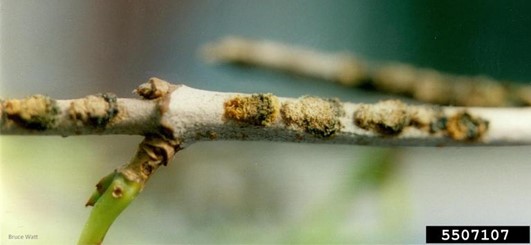Issue 12, October 8, 2022
Fall Control Options for Viburnum Leaf Beetle
Viburnum leaf beetle (Pyrrhalta viburni) larvae feed on members of the Viburnum genus causing significant defoliation. While the larvae are active in May and June, there are some steps that can be taken in the fall to reduce or prevent injury the following year.
Fall Mechanical Control
From July until frost, adult females create a cavity along viburnum twigs where they deposit eggs. They cap the egg cavities with a combination of plant material, saliva and frass. As temperatures cool and the beetles stop laying eggs, the eggs can be removed to reduce egg hatch in the spring.
Eggs can be removed from viburnum by pruning out infested twigs. The egg cavity caps (shown below) will be easier to find when the leaves have dropped in the fall. After the twigs have been removed, they should be burned, buried or discarded in a location away from the viburnum plants. This is one of the most effective ways to reduce viburnum leaf beetle populations.

Viburnum leaf beetle egg cavity caps, Bruce Watt, University of Maine, Bugwood.org
Fall Cultural Control
Planting varieties of viburnum that are less susceptible to viburnum leaf beetle attack is a good way to avoid injury from this insect all together. These varieties include: David viburnum (Viburnum davidii), dawn viburnum (V. bodnantense), doublefile viburnum (V. plicatum or V. plicatum var. tomentosum), Judd viburnum (V. x juddii), Koreanspice viburnum (V. carlesii), leatherleaf viburnum (V. rhytidophyllum), Siebold viburnum (V. sieboldii), or tea viburnum (V. setigerum).
Author:
Sarah Hughson